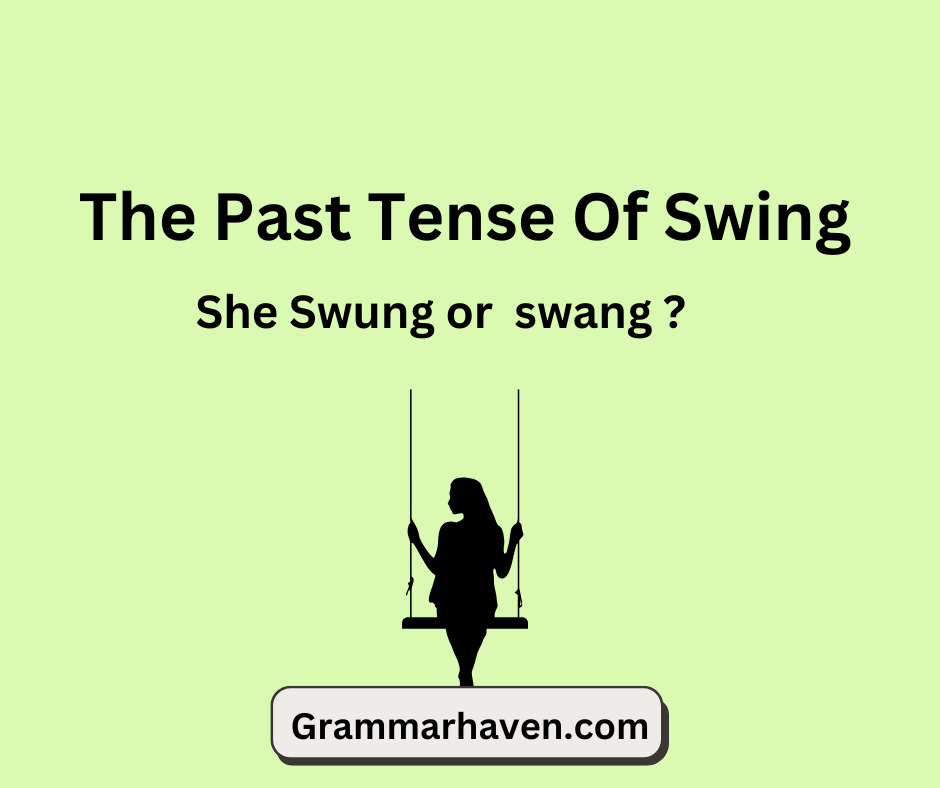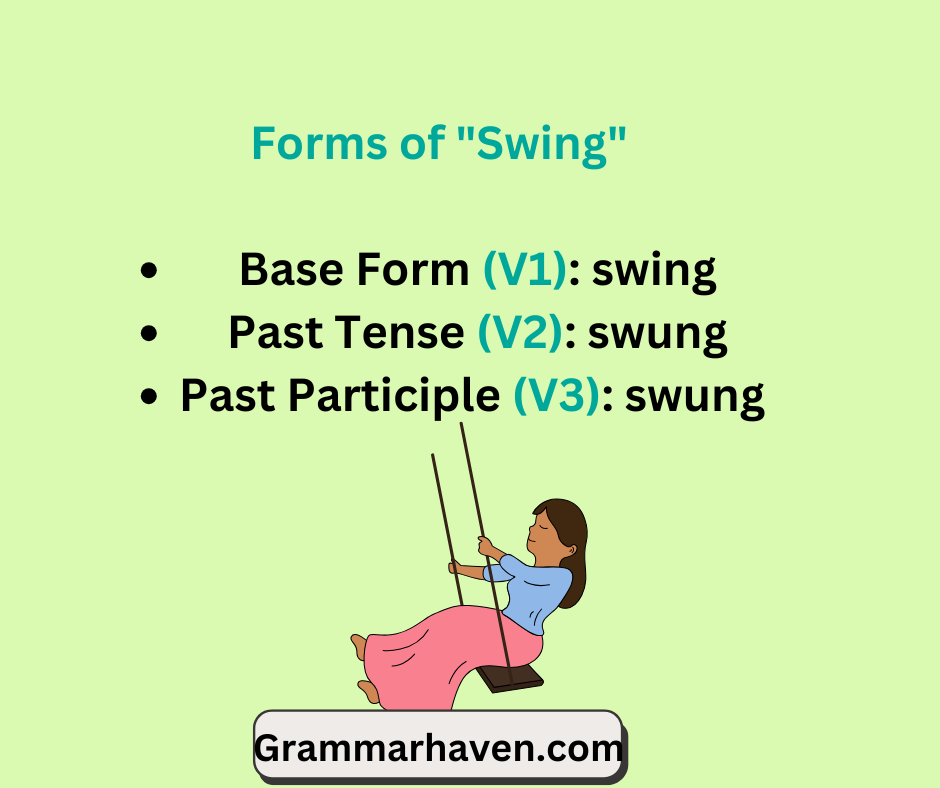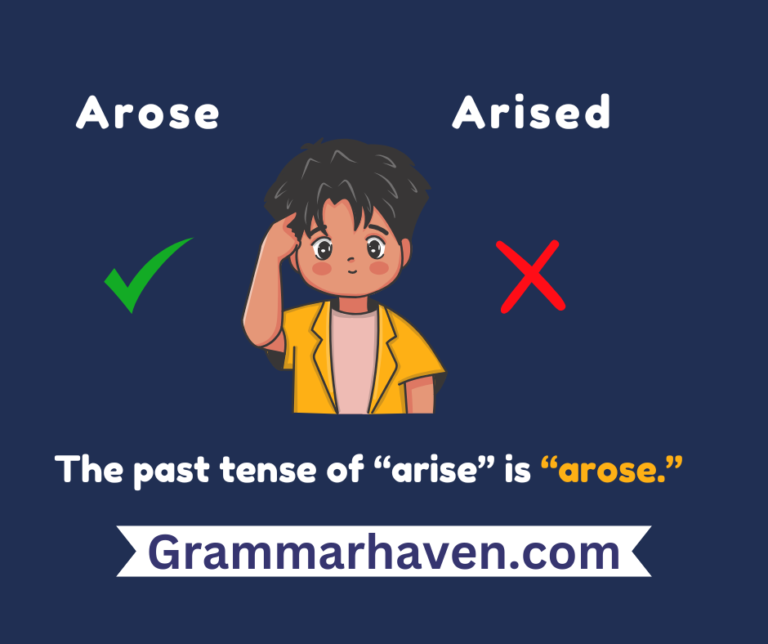What is the past tense of swing? Is it swing, swang or swung?
Understanding the past tense of “swing” is a quite important , as many people mistakenly believe it to be “swang.” In this article, we will clarify the correct usage of the past tense form, which is actually “swung,” while dispelling common misconceptions surrounding this tricky verb. By the end, you’ll confidently use “swung” in your writing and conversations.

What does the word “swing” mean?
The verb “swing,” means” to move back and forth or side to side repeatedly,” and the past tense of the verb “swing” is “swung”. The word “swing” has multiple meanings depending on the context.
Physical Movement – A rhythmic back-and-forth motion, like a pendulum or something suspended.
Playful/Forceful Action – Describes movements such as:
- A child on a playground swing.
- A baseball bat making contact with a ball.
Metaphorical Use – Represents changes in:
- Opinions
- Emotions
- Situations
Swing, swang or swung?
The past tense of the verb “swing” is “swung” .It follows a pattern of irregular verbs to form past tense ,unlike other regular verbs that follow the standard “-ed” ending rule for past tense.
Example : In the present, you might say, “I swing my tennis racket during practice.” But when talking about yesterday, you’d say, “Yesterday, I swung my tennis racket during practice.”

What’s the past tense of “swing”?
The past tense of swing is “Swung”.
Present form : Swing (Usage )I swing, you swing, he/she/it swings, we swing, they swing
Past Form: Swung (Usage ) I swung, you swung, he/she/it swung, we swung, they swung
Past Participle : Swung (Usage ) have/has/had.
Present Participle :Swinging
Here we can say that “Swung” acts as both the simple past tense and the past participle of “swing.” It doesn’t follow the pattern of “swinged” or “swang,”like regular verbs instead it acts as irregular verb same as “see “.So, keep in mind that when you want to write or speak about past actions involving swinging, the correct form is always “swung.”
Point to Remember :
To form the perfect and continuous tense auxiliary verbs need to be paired with participles, indicating an action as ongoing or continuing up to a specific point in time, We need to use helper verbs like “have,” “has,” and “had” with participles to create these more complex tense structures.

How to pronounce “swing” and “swung”
Pronouncing “swing”:
Though Pronouncing “swing” is easy, yet this guide offers an interesting way to explore phonetics.
Swing: /swɪŋ/ – It rhymes with “ring” or “sing”
- Start with the “s” sound, as in “sun”
- Followed by the short ‘i’ as in ‘sit
- Finish with the ‘ng’ sound, similar to the end of ‘bring.’
Pronouncing “swung”:
Swung: /swʌŋ/ – It rhymes with “hung” or “rung”
- Start with the “s” sound, as in “sun”
- Move to a short “wu” sound, like in “wood”
- End with the “ng” sound, as in “sung”
Origin of the word “swing”
The word “swing” originates from Old English, where it was spelled as “swengan” or “swengen.” It evolved from the Proto-Germanic word “swengwan,” meaning “to shake” or “to whip.” Over time, its meaning expanded beyond physical movement to include rhythmic motions and figurative shifts in opinions or emotions. This linguistic journey highlights how “swing” has retained its core essence of motion and energy while adapting to various contexts in language and culture.
Synonyms of “swing” and “swung”
Synonyms for “swing” with meanings:
- Sway – To move back and forth or side to side gently, often due to wind or external force.
- Rock – To move gently or forcefully back and forth or side to side.
- Oscillate – To move in a regular pattern between two points, like a pendulum
- Wave – To move in a rising and falling motion, often like water or a flag.
- Pivot – To turn or rotate around a central point.
- Glide – To move smoothly and effortlessly, often without interruption.
- Rotate – To turn around an axis or central point
- Fluctuate – To shift back and forth irregularly, often in levels or amounts
- Twist – To turn or coil something in a spiral motion.
- Propel – To push or drive something forward with force.
Synonyms for “swung” with meanings:
- Swayed – Moved back and forth or side to side gently.
- Rocked – Moved rhythmically or forcefully back and forth.
- Oscillated – Moved in a steady back-and-forth motion, like a pendulum
- Waved – Moved up and down or side to side in a flowing motion.
- Pivoted – Turned or rotated around a central point.
- Glided – Moved smoothly and effortlessly.
- Rotated – Turned around an axis or central point.
- Fluctuated – Changed back and forth unpredictably.
- Twisted – Moved in a spiral or contorted shape.
- Propelled – Pushed or moved forward with force.
Using “swing” and “swung” in sentences
Using “swing” in a sentence:
Use of swing in different contexts :
- Physical Movement: My children love to swing on the playground.
- Sports: My brother took a powerful swing at the baseball.
- Mood Change: Her emotions often swing from excitement to frustration.
- Decision Making: The debate could swing voters in either direction.
- Dancing: Her children learned how to swing dance at the party.
Using “swung” in a sentence:
- She swung her backpack over her shoulder and walked out.
- The monkey swung from branch to branch effortlessly.
- The door swung shut with a loud bang.
- He swung his fist but missed the target.
- The mood of the crowd swung from excitement to disappointment.
Explore how other languages express the concept of “swing”
- Spanish: Balancear (to sway/swing), columpiarse (to swing on a swing)
- French: Balancer (to swing/sway), se balancer (to swing oneself)
- German: Schwingen (to swing, oscillate), schaukeln (to rock/swing)
- Italian: Oscillare (to oscillate/swing), dondolare (to rock/swing gently)
- Portuguese: Balançar (to swing/sway), oscilar (to oscillate)
- Russian: Качаться (kachat’sya) (to swing back and forth), раскачиваться (raskachivat’sya) (to sway)
- Chinese (Mandarin): 摇摆 (yáobǎi) (to sway/swing), 荡秋千 (dàng qiūqiān) (to swing on a swing)
Conclusion:
Mastering the past tense of “swing” would be a stepping stone on your path to becoming proficient in English. As you continue to learn, keep in mind that “swung” is the correct form, distinguishing it from the commonly mistaken “swang.” This verb follows the same irregular pattern as others, such as “ring” (rang) and “sing” (sang), emphasizing the importance of recognizing these unique forms. Regular practice will help you incorporate “swung” into your vocabulary, reinforcing its usage in everyday conversations.
Sources : English Language& Usage , Merriam-Webster .
FAQS
What is the past tense of “swing”?
The past tense of swing is “Swung”.
What is the present participle of “swing”?
The present participle of swing is swinging .
What is the 3rd form of swing?
The third form (past participle) of “swing” is “swung.”
Forms of “Swing”
Base Form (V1): swing
Past Tense (V2): swung
Past Participle (V3): swung
What is meant by “swung”?
Swung is the past simple and past participle of swing. It means Shaking, swinging and vibrating.
What is the difference between swing and swung?
The verb “swing,” means” to move back and forth or side to side repeatedly,” and the past tense of the verb “swing” is “swung”.When discussing actions or events that occurred in the past involving the act of swinging, whether in a literal or metaphorical sense, “swung” is the correct form to use.




